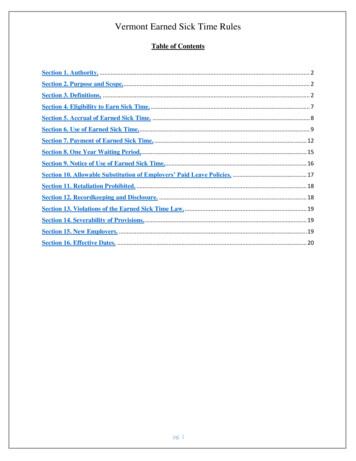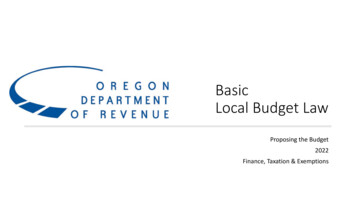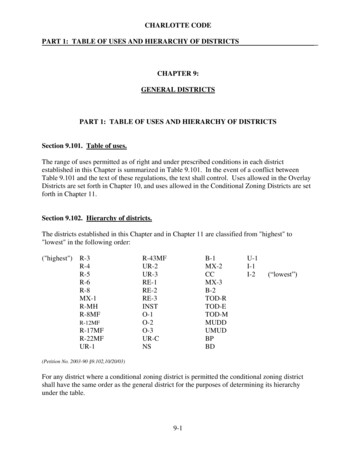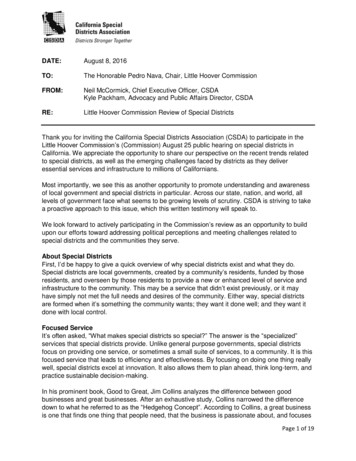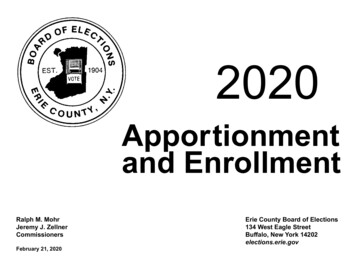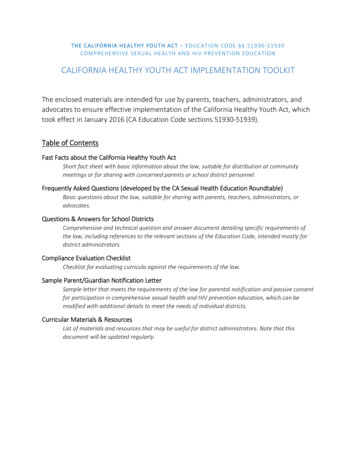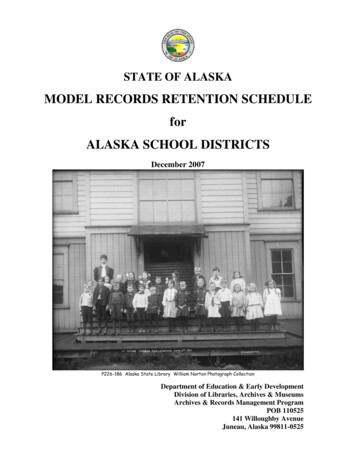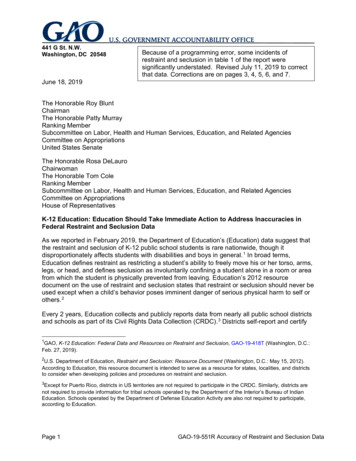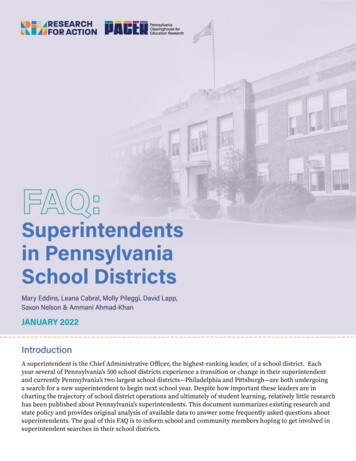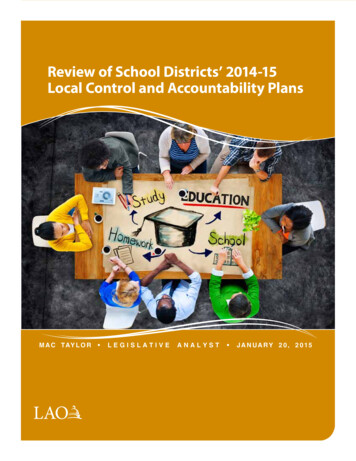
Transcription
Review of School Districts’ 2014-15Local Control and Accountability PlansM A C TAY L O R LEGISLATIVEANALYST JA N UA RY 2 0 , 2 0 15
AN LAO REPORT2Legislative Analyst’s Office www.lao.ca.gov
AN LAO REPORTEXECUTIVE SUMMARYNew System of School Funding, Support, and Intervention Recently Established. The 2013-14Budget Act and associated legislation created a new school funding formula—the Local ControlFunding Formula (LCFF). The LCFF provides districts with base funding tied to four grade spans;supplemental funding for English learner, low-income, and foster youth (EL/LI) students; andconcentration funding for districts with relatively high proportions of EL/LI students. The legislation also created a new system of planning and support. The new plans—called Local ControlAccountability Plans (LCAPs)—require districts to set goals and describe the actions they plan totake to achieve those goals. The plans also require districts to describe the enhanced services theywill provide to support EL/LI students given the higher funding rates provided for them. The newsystem of support is centered around performance evaluations, known as rubrics, that are intendedto assess districts’ performance and guide county offices of education, the California Collaborativefor Educational Excellence (a newly authorized network of educational specialists), and theSuperintendent of Public Instruction in providing assistance when districts fail to improve.Report Reviews First Year of LCAP Development, Assesses Usefulness of New Plans. Thisreport examines 50 LCAPs to evaluate their compliance with statutory requirements and determinewhether LCAPs overall reflected thoughtful strategic planning by districts. To select 39 of thedistricts for our sample, we created categories of large, mid-size, and small districts based on totalenrollment and then, within each of these size categories, we selected some districts that had high,average, and low EL/LI enrollment. We added the state’s 11 largest districts to round out our sample.Our sample contains districts from many geographic areas of the state.Findings and AssessmentStatute Sets Ambitious Requirements for LCAPs. One of our most significant findings relatesto the overarching design of the LCAP. The statute governing the components of the LCAP requiresdistricts to set goals in eight state priority areas, identify and describe actions to reach those goals,and track progress using 24 state-identified metrics (plus any local metrics). In addition, the statuteinstructs districts to set specific goals and identify actions for 12 student subgroups and each of thedistricts’ schools for all the priority areas. Fulfilling all of these requirements is a challenging undertaking for districts to accomplish and accomplish well. Though most of the LCAPs we reviewedattempted to comply with many of the statutory LCAP requirements, none compiled with everystatutory requirement.Districts Rarely Differentiate Between New and Ongoing Actions. In most LCAPs, we foundthat districts are not distinguishing between actions that are a continuation of efforts from the prioryear and those that are new for the upcoming school year. Without such differentiation, we couldnot determine whether districts were using the new funding generated under LCFF to pursue newactions to improve performance or to continue or expand prior activities.Districts Often Fail To Provide Sufficient Information on EL/LI Student Services. Often,districts’ descriptions of services for EL/LI students consist only of recapping the actions theywww.lao.ca.gov Legislative Analyst’s Office3
AN LAO REPORTwill pursue on behalf of all students and indicating those actions also will benefit EL/LI students.In addition, few districts provide clear or compelling rationales for using their supplemental andconcentration funds on a districtwide and schoolwide basis.RecommendationsEmphasize Clear, Strategic Plans Over Detailed, Comprehensive Plans. Despite the complexityof the LCAP requirements, we believe the LCAP can be a useful tool for helping districts developstrategic plans. To help ensure that LCAPs can evolve into meaningful plans, we recommend theLegislature allow all districts to focus their plans on their highest-priority areas rather than requirethem to address all eight state-specified priority areas. For the smaller set of high-priority areas, werecommend the Legislature continue to require districts to identify the actions they plan to taketo improve their performance and track their outcomes. To ensure districts address areas of poorperformance, we recommend the Legislature require districts to include in their LCAPs their mostcritical areas in need of improvement, as identified by the evaluation rubrics. While moving fromcomprehensive to focused plans would reduce the amount of information available in districts’LCAPs, the evaluation rubrics will provide comprehensive assessments of districts’ performanceacross all priority areas, metrics, and subgroups. Moreover, most of the metrics currently required inthe LCAP are publicly available through the state’s existing data systems.Require Districts To Indicate Whether Actions Are New or Ongoing. For any priority areascontained in a particular LCAP, we recommend the Legislature require the district to distinguishbetween new and ongoing actions. This distinction will provide clarity on where districts aremaking new investments and help identify which particular strategies may be affecting studentoutcomes.Monitor Quality of Information Regarding EL/LI Students. We encourage the Legislature tomonitor districts’ EL/LI information over the next few years to determine if districts’ descriptionsof EL/LI services improve. To this end, we recommend the Legislature conduct an informationalhearing during fall 2016 to solicit feedback from school districts, county offices of education, andcommunity groups about the quality of this information. In the meantime, we recommend theLegislature enact several more modest changes to statute to improve the quality of informationdistricts provide.Disseminate Information on Key Ingredients of Effective Strategic Plans. We recommend theLegislature direct the California Department of Education to disseminate examples of model LCAPsto districts. These model LCAPs could help guide districts in developing more thoughtful plans inthe years to come.4Legislative Analyst’s Office www.lao.ca.gov
AN LAO REPORTINTRODUCTIONThis report reviews first-year Local Controland Accountability Plans (LCAPs) to evaluatetheir compliance with statutory requirements anddetermine whether the plans are a useful approachfor improving school districts’ performance. First,we discuss the development of the Local ControlFunding Formula (LCFF), LCAPs, and the newsystem of school district support and intervention.Second, we describe our method for selecting andanalyzing a sample of 50 LCAPs. Third, we layout our findings and assessment of the LCAPs wereviewed. Lastly, we provide recommendations foradjustments to the LCAP to enhance its role as astrategic planning tool for districts.BACKGROUNDNew Funding Formula Based on Studentadopted a new system of support and interventionCharacteristics. Legislation enacted in 2013-14for school districts. The new system is foundedmade major changes to the way the state allocateson annual plans and performance evaluations,funding to school districts. Previously, more thanknown as rubrics. The plans—the LCAPs—require40 state categorical programs constrained districts’districts annually to develop and adopt three-yearspending choices—providing restricted state dollars plans to improve student achievement. Thethat districts could use for only certain activities.evaluation rubrics allow districts, county officesBy enacting LCFF, the state replaced the historicalof education (COEs), and the Superintendent ofrevenue limit and categorical funding systemPublic Instruction to assess districts’ progresswith a student-oriented, formula-based fundingtowards improving student outcomes. Under thesystem. As displayed in Figure 1, the LCFF providesnew system, districts then use those assessments todistricts with base funding tied to four gradeguide future plans and actions. Figure 2 (see nextspans; supplemental funding for English learner,page) reflects the iterative improvement processlow-income, and foster youth (EL/LI) students; andunderlying the new system.concentration funding for districts with relativelyhigh proportions ofEL/LI students. UnderFigure 1the LCFF model, districtsPer-Student Funding Under LCFFserving the same numberGradeBaseSupplementalConcentrationof students in the sameSpansRatesaFundingbFundingcgrade spans with the sameK-3 7,741 1,548 3,870characteristics receive the4‑67,1161,4233,5587‑87,3281,4663,664same amount of funding.9‑128,7111,7424,356New System Toa Reflect 2014‑15 target rates. These target rates are adjusted annually by the K-12 inflationary index. Weestimate that on average the state funded 80 percent of these rates in 2014-15.Improve Studentb Equals 20 percent of the associated grade-span base rate. Applies to all English learner, low-income,Outcomes. In conjunctionand foster youth (EL/LI) students.c Equals 50 percent of the associated grade-span base rate. Applies to districts in which EL/LI enrollmentwith establishing the newis above 55 percent of total enrollment. Only generated by students above the threshold.LCFF Local Control Funding Formula.funding formula, the statewww.lao.ca.gov Legislative Analyst’s Office5
AN LAO REPORTState Requires Districts to Develop PlansStatute Requires Districts To Set Goalsand Identify Related Actions and Funding. Thelegislation enacting LCFF laid out the frameworkfor LCAPs. The framework is centered arounddistricts’ goals and the process for districtsto develop and adopt those three-year plans.Specifically, statute requires districts to set goalsand to describe the actions they plan to taketo achieve those goals. Statute further requiresdistricts to identify the associated fundingsupporting each planned action and align theirLCAPs with their budgets to demonstrate thatsufficient funding is allocated to support all of theplanned actions. (For example, a school districtcould specify that it intends to provide tutors toall EL students below grade level to improve itsreclassification rate. To ensure the LCAP andadopted budget are aligned, the school district mustinclude sufficient funding for tutors in its adoptedbudget.)Statute Establishes Eight Priority Areas and24 Performance Indicators. For each goal a districtsets, statute requires that districts align the goalwith one or more of eight state priority areas. Asshown in Figure 3, the priority areas span fromstudent achievement and engagement to parentalinvolvement and basic services (such as teachersand textbooks). For each state priority area, statutespecifies certain performance indicators intendedto monitor districts’ performance. Statute lists atotal of 24 performance metrics (see Figure 3). Thepriority area with the greatest number of associatedperformance metrics (8 of the 24) is the studentachievement area. Metrics in this area includestudent performance on standardized tests, EnglishLearner reclassification rates, and the share ofGraphicstudents that pass Advanced Placement examswith Sign Offa score of 3 or higher. In addition to addressingtheSecretarystate priority areas, statute allows districts’AnalystLCAPsto include locally developed metrics.DirectorStatute Requires Districts To EstablishDeputyPerformance Targets. For each of the 24performance metrics and any locally developedmetrics, statute requires districts to establishperformance targets for all students and studentsubgroups and schools. (Statute identifies 12student subgroups—eight student racial andFigure 2Continuous Planning and Evaluation SystemDistrict LCAP Development and/or UpdateCOE Support (If Needed)COE Assessment of District PerformanceDistrict LCAP Adoption and COE ApprovalDistrict LCAP ImplementationLCAP Local Control and Accountability Plan and COE county office of education.6Legislative Analyst’s Office www.lao.ca.gov
AN LAO REPORTethnic groups as well as English Learners,low-income students, foster youth, and studentswith disabilities.) Statute requires that districtsestablish these targets for the coming school year aswell as the next two years. Figure 4 (see next page)provides a simplified illustration of the relationshipamong goals, priority areas, actions, metrics, andtargets.Statute and Regulations Contain AdditionalSet of Requirements for EL/LI Services. Statutespecifies that a district must “increase or improveservices” for EL/LI students “in proportion tothe increase” in its LCFF supplemental andconcentration funding. Statute also allowsdistricts to use supplemental and concentrationfunding on a districtwide or schoolwide basis.Statute directs the State Board of EducationGraphic Sign Off(SBE) to develop regulations implementing theseSecretaryprovisions. Regulations allow districts to reflectAnalysttheir increase or improvement in services inDirectorvarious ways. Districts demonstrate adherencewith the regulations through their LCAPs.DeputyIn theirLCAPs, districts must report the total amountof supplemental and concentration funding theyexpect to receive. They also must report the resultof a complicated formula known as the “minimumproportionality percentage.” This formula isintended to link the proportional increase inFigure 3The Eight State Priority Areas and Associated MetricsStudent AchievementParental Involvement Efforts to seek parent input. Promotion of parental participation.Performance on standardized tests.Score on Academic Performance Index.Share of students that are college and career ready.Share of English learners that become Englishproficient. English learner reclassification rate. Share of students that pass Advanced Placementexams with 3 or higher. Share of students determined prepared for collegeby the Early Assessment Program.Student Engagement School attendance rates. Chronic absenteeism rates. Middle school dropout rates. High school dropout rates. High school graduation rates.Basic Services Rate of teacher misassignment. Student access to standards-alignedinstructional materials. Facilities in good repair.Implementation of State Standards Implementation of Common Core State Standardsfor all students, including English learners. Implementation of English language developmentstandards.Other Student OutcomesCourse Access Other indicators of student performance inrequired areas of study. May include performanceon other exams. Student access and enrollment in all requiredareas of study.School Climate Student suspension rates. Student expulsion rates. Other local measures.www.lao.ca.gov Legislative Analyst’s Office7
AN LAO REPORTfunding with the proportional increase in services,but it does not explicitly require a certain level ofEL/LI spending. In addition, districts must describehow they plan to use their supplemental andconcentration funding for the benefit ofEL/LI students. Districts’ LCAPs also must containjustifications if supplemental and concentrationfunding is not targeted to services specifically forEL/LI students, with higher justification for thosewith low shares of EL/LI students.Districts Must Use LCAP Template Createdby SBE. Statute creating the LCAP directed SBEto develop an LCAP template. The template isdesigned to cover all the statutory LCAP elements(goals, actions, funding, alignment with priorityareas, performance indicators, and targets) andcreate some consistency across districts’ LCAPs.The template contains some guidance for districtson how to develop their plans but does notprescribe any particular actions districts musttake. The template provides space for districtsto differentiate between services for all studentsand those for EL/LI students. The first iteration ofthe LCAP template was created in the spring of2014 for LCAPs covering the 2014-15 school year.For the 2015-16 LCAPs, the SBE adopted anupdated template.Districts Required To Solicit Input FromStakeholders in Developing LCAPs. The LCAPlegislation also laid out the process by whichdistricts were to develop and adopt their plans.Statute requires that districts involve variouslocal community groups in plan development.Specifically, statute requires that districts consultwith teachers, principals, administrators, parents,and students to determine what strategies theybelieve will improve student outcomes. Districtshave some flexibility in determining how best toengage these groups. To ensure parents are involvedin the LCAP process, statute requires that districtspresent the LCAP to the district parent advisorycommittee and the English learner parent advisoryGraphic Sign Offcommittee (if applicable). In addition, the districtSecretarymust provide the opportunity for publiccommenton the plan and hold at least one publichearingAnalystto solicit recommendations and commentsMPA frommembers of the public. School districts’boardsDeputymust approve their LCAPs annually by July 1.Boards approved their first round of LCAPs byJuly 1, 2014.Figure 4Simplified Illustration of Goals, Priority Areas, Actions, Metrics, and TargetsGoalEnsure all studentsare prepared forcollege or a careerupon graduation.Priority AreasActionsOffer additional sciencecourses to ensurestudents meet universityprerequisites.MetricsPerformance on10th grade sciencestandardized test.Number of newscience teachers hired.StudentAchievementState metricCourseAccess8Legislative Analyst’s Office www.lao.ca.govLocal metricYear 1TargetsYear 2Year 375% proficient80% proficient82% proficient2 teachers1 teacher2 teachers
AN LAO REPORTCOEs Must Review District Plansand May Suggest ChangesSBE Developing Criteria forIdentifying Struggling DistrictsCOEs Can Ask for Clarification and MakeRecommendations To Improve Districts’ Plans.Each district must submit its LCAP to its COE forreview. The COE can then seek clarification fromthe district about the contents of its LCAP. If a COEseeks such clarification, a district must respond inwriting. Based on a district’s response, the COEcan submit recommendations for amendments tothe LCAP back to the district. The district mustconsider any COE recommendations at a publichearing, but the district is not required to makechanges to its plan. The COE must approve adistrict’s LCAP if it determines that (1) the LCAPadheres to the SBE template, (2) the district’sbudgeted expenditures are sufficient to implementthe strategies outlined in the LCAP, and (3) theLCAP adheres to the expenditure requirementsfor supplemental and concentration funding.Districts and COEs went through the first LCAPreview process in the summer of 2014. The annualdeadline for approval or rejection of a district’sLCAP by a COE is October 8. For the 2014-15school year, COEs approved the vast majority ofLCAPs submitted by districts by the deadline. Ourunderstanding is a handful of districts requiredtechnical support from COEs in order to have theirLCAPs approved.Struggling Districts To Be Identified andSupported. The SBE is developing rubrics toevaluate districts’ performance. The evaluationrubrics will serve two functions—allow districtsto evaluate their strengths and weaknesses andallow COEs and the Superintendent of PublicInstruction to gauge whether districts areimproving outcomes for students. The rubricsare to be comprehensive and consider multiplemeasures of district and school performance. Inaddition, statute requires the rubrics to set statelevel expectations for improvement in each ofthe eight state priority areas. These expectationsare the basis for determining whether districtsrequire support or intervention from COEs, theCalifornia Collaborative on Educational Excellence,the Superintendent of Public Instruction, or otherexternal advisors.Components of Rubrics To Be Developed bySBE. Within the guidelines laid out above, statutegives the SBE discretion over the content anddesign of the rubrics. Of particular note is theSBE’s latitude in setting state-level expectations forimprovement, thereby affecting which districts andhow frequently districts are identified for additionalsupport. The SBE must adopt evaluation rubrics byOctober 1, 2015. Districts’ 2015-16 data likely willserve as the baseline for determining if districtsare meeting the state-level expectations set forthby SBE in the rubrics. (Districts begin receivingsupport after they have failed to improve outcomesin at least one state priority area.)ANALYSIS OF 2014-15 LCAPSReviewed 50 LCAPs. Our review aimed tosummarize the content of a sample of LCAPs—including districts’ goals, actions, metrics, and usesof supplemental and concentration funding—andidentify common themes among the plans. As partof this review, we examined whether the LCAPswww.lao.ca.gov Legislative Analyst’s Office9
AN LAO REPORToverall reflected thoughtful strategic planning bydistricts. We did not aim to critique the specificprogram decisions made by particular districts,but rather explored the fundamental usefulnessof LCAPs as implemented by districts in 2014-15.We read and catalogued 50 LCAPs representing adiverse set of districts.Sample Included Districts of Different Sizesand EL/LI Enrollment. To select the bulk (39) ofdistricts for our sample, we created categories oflarge, mid-size, and small districts based on totalenrollment. Within each of these size categories,we selected some districts that had high, average,and low EL/LI enrollment. Using this stratificationmethod, we selected 21 large districts (withenrollment between 10,000 and 50,000 students), 9mid-size districts (with enrollment between 5,000and 10,000), and 9 small districts (with enrollmentunder 5,000 students). We then added the state’s 11largest districts to round out our sample. These 11districts alone comprise 18 percent of enrollmentin the state. Our entire sample covers 26 percentof enrollment across the state. In selecting specificdistricts for our sample, we also ensured geographicdiversity. Our sample contains districts from24 (of 58) counties, as displayed in Figure 5.Interviewed Some COE and District Staff.To better understand the LCAP developmentand review process, we spoke to several COEsand districts about how the process worked forthem. Our questions for districts focused on howthey engaged their communities, who within thedistricts worked on LCAP development, and whatimpact the LCAP process had on districts’ plansfor the school year. We asked COEs about theirprocesses for reviewing districts’ LCAPs, focusingon how COEs supported districts through theprocess. These interviews provided helpful contextthat enriched our LCAP analysis. Figure 6 (see page12) summarizes our major findings and assessment,which we discuss in more detail next.10 Legislative Analyst’s Office www.lao.ca.govLCAP DesignStatute Establishes Ambitious Set ofRequirements. The statute governing thecomponents of the LCAP requires districts to setgoals in all eight state priority areas, identify anddescribe actions to reach those goals, and trackprogress using 24 metrics (plus any local metrics).In addition, the statute instructs districts to setspecific goals and identify actions for 12 studentsubgroups and each of their schools for all thepriority areas. Taken together, these requirementsare a daunting undertaking for districts toaccomplish and accomplish well. Though most ofthe LCAPs we reviewed attempted to comply withmany of the statutory LCAP requirements, nonecompiled with every statutory requirement.First SBE Template Very Complex. Theorganization of the first SBE template separateddistricts’ actions from their associated metrics. Thisdisjointed template design created challenges fordistricts to develop coherent strategies that alignedtheir goals, actions, and metrics. In some cases,we also found that districts listed metrics thatwere not measuring the impact of the actions theychose to pursue. This made tracking the impact ofdistricts’ actions on student outcomes particularlychallenging.New Template Organizes Information in MoreUseful Way. The new template recently adoptedby SBE groups all of the relevant informationassociated with a particular goal together.This organizational change will not condenserequired information, but it will ensure that allrelated information is in the same section. Asa result, readers will be able to identify whicharea of improvement each goal is addressing, theactions to be taken to address the goal, and themetrics the district will use to measure progresstowards meeting the goal. Moreover, the newtemplate should help districts better establishthe relationship between their areas in need of
AN LAO REPORTSecretaryAnalystMPADeputyFigure 5Districts Included in Our SampleSample 50 districts. Districts comprise 26 percentof statewide enrollment located in 24 counties. 19 High EL/LI districts. 16 Average EL/LI districts. 15 Low EL/LI districts.Note: “High” districts are defined as those with morethan 75 percent EL/LI enrollment, “average”districts between 50 percent and 75 percentEL/LI enrollment, and ”low” districts less than50 percent EL/LI enrollment.EL/LI English learner, low-income and foster youth students.Template CA County Map.aitARTWORK#140598www.lao.ca.gov Legislative Analyst’s Office 11
AN LAO REPORTimprovement, goals, and actions, which shouldresult in better plans.LCAP Has Potential as Strategic Plan. Thoughthe first LCAP template had notable shortcomings,we believe the revised LCAP template hasovercome some of those issues and is a more usefulframework for helping districts develop coherentplans. Despite the refinements to the template,however, the fundamental challenge for districtsin developing clear LCAPs remains the tensionbetween being comprehensive versus focusing onthe areas in greatest need of improvement.GoalsSome Districts Lack Overarching Goals.Whereas some districts’ LCAPs focus on a few,key overarching goals (such as improving collegeand career readiness), other districts set manynarrow goals (such as reducing the dropout rate by5 percent, decreasing the teacher misassignmentrate to 2 percent, and increasing the numberof science courses offered). When districts setnumerous, narrow goals without any broader ones,the overall direction and emphasis of those districtscan be more difficult to follow.Figure 6Summary of Major Findings and AssessmentFindingsAssessmentLCAP Design Statute establishes ambitious set ofrequirements, including requiring districtsto set goals for 12 student subgroups andeach of their schools. LCAP has potential as a strategic plan ifrefined to be more focused on districts’key performance issues.Goals andPriority Areas Some districts lack overarching goals. Statute appears to emphasize eightstate priority areas equally. Districts areprioritizing among them. Districts’ goals not targeted to areas ingreatest need of improvement. In some cases, districts do not appearto be carefully considering whichpriority areas to align with their goals.Actions Districts pursuing relatively similaractions. Detail of districts’ actions varies widely.Some provide step-by-step information,while others only provide generalinformation. Districts vary in extent to which they linkfunding with actions. Districts rarely differentiate betweennew and ongoing actions, makingunderstanding new strategies difficult. Districts vary in which funding sourcesthey include, thereby omitting someactions supported with non-LCFFfunding.Metrics and Targets Districts include some, but not all metricsand targets in their LCAPs. Most districts set single target for allstudents. Many metrics do not apply to elementaryschool districts. Districts rarely include baseline datafor metrics, making targets lessmeaningful.EL/LI Services Districts’ information on EL/LI servicesvaries. Difficult to determine if and how districtsare improving services. Districts often fail to justify rationale forproviding districtwide or schoolwideservices.LCAP Local Control and Accountability Plan; SBE State Board of Education; LCFF Local Control Funding Formula;COEs county offices of education; and EL/LI English learner, low-income and foster youth.12 Legislative Analyst’s Office www.lao.ca.gov
AN LAO REPORTIn Many Cases, Districts’ Goals Not WellAligned to State Priority Areas. Few districts’ goalsfocus on a single priority area. Instead, districts setgoals and then align priority areas to those goals.As a result, each priority area often is attributedto multiple goals. In some cases, districts attributeall priority areas to all their goals even when littleconnection between the goals and priority areasexists. In these cases, districts do not appear to becarefully considering which priority areas alignwith their goals. Districts may have set goals firstand then aligned the priority areas to those goalsdue to the template design. The template first askeda district to set goals and then asked what priorityarea each goal covered.Eight State Priority AreasStatute Appears To Emphasize Eight StatePriority Areas Equally, Districts Are PrioritizingAmong Them. Both current law and the originaland revised LCAP template enumerate the eightstate priority areas without any indication thatone priority area should receive greater attentionthan another. As a result, the state is indicating todistricts that all priority areas are of equal value.Despite the apparent equal weighting among thepriority areas in statute, districts do not appearto be emphasizing them equally. In most cases,districts are setting goals that span multiplepriority areas, with some priority areas appearingmore frequently than others. For example, thestudent achievement priority area commonly isaligned with districts’ goals whereas the parentalinvolvement priority a
known as rubrics. The plans—the LCAPs—require districts annually to develop and adopt three-year plans to improve student achievement. The evaluation rubrics allow districts, county offices of education (COEs), and the Superintendent of Public Instruction to assess districts' progress towards improving student outcomes. Under the
